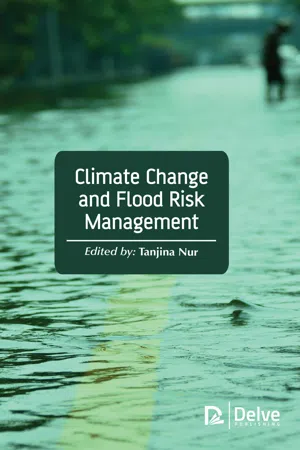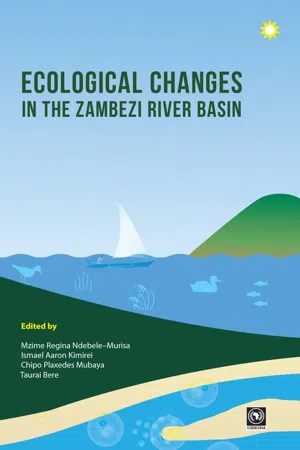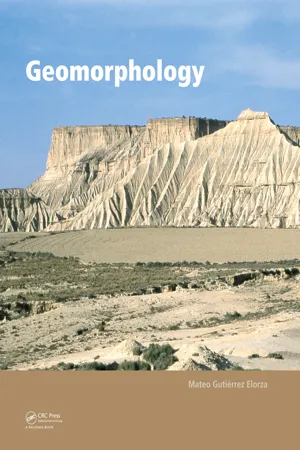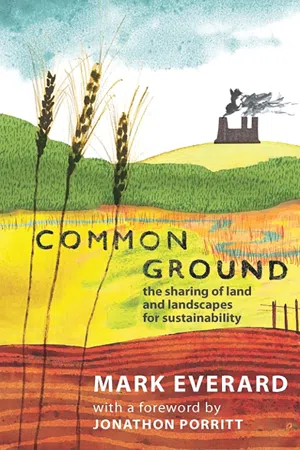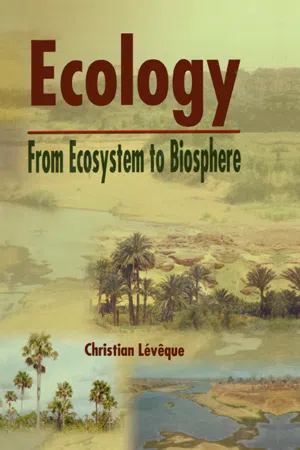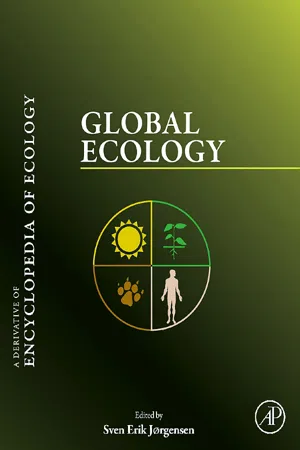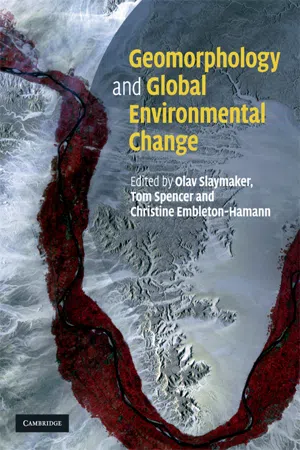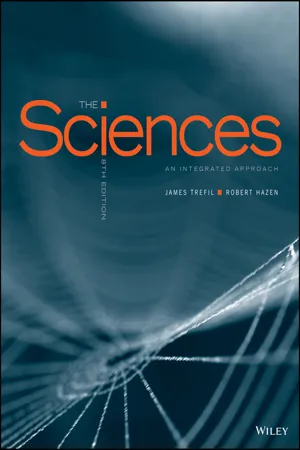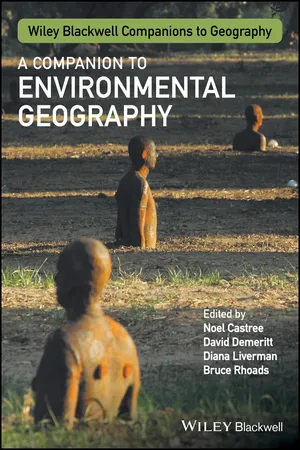Geography
Changes to Ecosystems
Changes to ecosystems refer to alterations in the structure and function of natural environments, often resulting from human activities or natural events. These changes can include shifts in species composition, disruptions to food webs, and modifications to physical landscapes. They can have significant impacts on biodiversity, ecological processes, and the services that ecosystems provide to humans.
Written by Perlego with AI-assistance
Related key terms
1 of 5
11 Key excerpts on "Changes to Ecosystems"
- eBook - PDF
- Tanjina Nur(Author)
- 2019(Publication Date)
- Delve Publishing(Publisher)
3.5 ECOSYSTEMS, BIODIVERSITY, AND ECOSYS-TEM SERVICES Climatic transformation affects the living world, which majorly includes people, via varied changes in ecosystems, biodiversity, and ecosystem services. Environmental constitutes all the living things in a specific area as well as the non-living things with which they relate, such as air, soil, water, and sunlight. Biodiversity refers, “to the variety of life, including the number of species, life forms, genetic types, and habitats and biomes (which are characteristic groupings of plant and animal species found in a particular climate).” Biodiversity and ecosystems together produce a rich collection of benefits that people depend on which includes fisheries, drinking water, fertile soils for growing crops, climate regulation, inspiration, and aesthetic and cultural values. These aids are known as “ecosystem services” among which, majorly food, is more easily quantified than others, such as climate regulation or cultural values. Changes in many such services are often not obvious to those who depend on them. 3.5.1 Water Climate-driven issues that control the availability of water along coasts and quality are moderated by ecosystems. Land-based ecosystems control the water cycle and are the foundation of sediment and other materials that make their way to aquatic ecosystems like streams, rivers, lakes, estuaries, oceans, groundwater. “Aquatic ecosystems provide the critically important services of storing water, regulating water quality, supporting fisheries, providing recreation, and carrying water and materials downstream”, according to Coasts. Humans apply, on average, the corresponding measure of more than 40% of renewable supplies of freshwater in around more than 25% of all U.S. watersheds. Climate Change and Flood Risk Management 72 Figure 3.12: Natural resource of water. - eBook - PDF
- Amrita Pandey(Author)
- 2019(Publication Date)
- Delve Publishing(Publisher)
Earth Systems and Environment 152 7.2.5. Climate Effects It is usually seen that within the past few years, due to increase in human activity, there has been significant impact on the climate. Human activity is directly associated with increase in the release of greenhouse gases into the air, which result in high emission level and uncertain environmental conditions. The climate change has significant impacts on many sectors and systems, including and ecosystem structure, biodiversity and functions. It is often seen that these changes will result in impacting the basic ecosystem services and thus, give rise to biogeochemical feedbacks in the ecosystems Research that studies that climate effects primarily interested in: • Impact of climate change on diversity of species in terrestrial ecosystems. • Assessing the impact of increase in carbon concentration into the water. • Process-based modeling about how the change in climatic conditions, atmospheric composition and land use influences ecosystems at various scales. • Examining the impact of extreme weather and climate events on forests, trees, marine and forestry. • Models and processes that can help in representing interactions between soils, vegetation, climate and ecosystem change. 7.3. THE CHANGING LAND SURFACE Figure 7.3: Climate change impact on land surface. Source: https://www.nps.gov/subjects/climatechange/images/KAHO_300x300. jpg?maxwidth=650&autorotate=false Global Change in the Earth Systems and Environment 153 The processes of erosion, weathering, and soil formation that together contributed in degradation of upland areas have operated throughout earth history. Variations that are the result of these processes are clearly observable in the present climate conditions. Glaciers form in the high altitudes or in the polar or sub-Polar Regions; deserts develop around 20 degrees from the equator; and rain forests, with their great rivers, grow in temperate latitudes and equatorial. - eBook - PDF
- Mzime Ndebele-Murisa(Author)
- 2021(Publication Date)
- Codesria(Publisher)
In addition, unsustainable fishing activities, overexploitation of aquatic resources, and the introduction of Trends in Ecological Changes 51 exotic species are changing the ecological settings and the balance of many of the ecosystems in the region (Ogutu-Ohwayo 1990; Kudhongania et al. 1992; Witte et al. 1992; Turner 1995; Millennium Ecosystem Assessment 2005). Introduction of exotic species, for example, has devastated the ecology of Lakes Kariba, Kivu and Victoria by changing species composition, dominance, diversity and probably some extinction of indigenous species (Ogutu-Ohwayo 1990; Kudhongania et al. 1992; Witte et al. 1992; Witte et al. 2009). This chapter explores trends in ecological changes in east and southern Africa with an emphasis on the Zambezi River Basin and highlights a case study of these changes as perceived by local communities within the Manyame catchment in Zimbabwe. States, Trends and Causes of Ecological Changes Ecological changes entail changes in biotic and abiotic factors. In this case, changes in the environment as well as biotic interactions within rivers and lakes ultimately affect the biophysical environment and interactions between humans and the environment. These changes can be shifts in species composition, distribution, and population dynamics or a complete alteration of the species flock; changes in water quality, physical habitat change and human ecological interactions. Ecological changes can be monitored or assessed using various indicators, such as fish species change (species, size, diversity and production), riparian vegetation cover and distribution, shifts in vegetation species diversity, macro-and micro-invertebrates diversity and distribution, metal pollution, eutrophication and nutrients enrichment in aquatic systems, phytoplankton and zooplankton dynamics, and sediment accretion rates (see Chapter 4 of this volume). - eBook - PDF
- Mateo Gutierrez(Author)
- 2012(Publication Date)
- CRC Press(Publisher)
19 ENVIRONMENTAL CHANGE 1. Introduction 2. The Earth’s climate system 3. Climate change and the greenhouse effect 4. Anthropogenic change 5. Toward sustainable development 19.1 Introduction Climate, sea level, vegetation zones, animal populations, soils, and landforms have all changed throughout Earth his- tory (Goudie, 1977a, 1992) but during the Quaternary con- tinuous environmental changes over very short time periods have become more obvious. From a geomorphic perspective, these recent environ- mental changes result from three basic causes: geological, climatic, and anthropogenic. Because the factors that trig- ger these changes interact or act together, it is it difficult to assess the contribution of each to environmental change. Changes of the geological environment are pri- marily due to neotectonic activity (Fig. 19.1), which may be significant in areas located along active plate margins where isostatic readjustments and relative lithospheric plate move- ments cause significant topographic change. Thus in moun- tain deserts and depressions (Mabbutt, 1977) that have notable crustal instability such in the western United States and central Asia, landforms will be affected by this activity. In contrast, shield deserts and platforms like the Sahara, India, and Australia are generally not affected by this endogenetic activity; it is easier to study of climate change in the latter areas because tectonic activity does not interfere. Although humans have populated the Earth for six or seven million years (Anderson et al., 2007) their interac- tion with the environment became important only during the agricultural revolution of the last 10,000 years and more so in the recent industrial and medical revolutions (Goudie, 1981b, 2006). Humans affect vegetation, fauna, soil, water, and climate, and thus man is considered a geomorphic agent (Nir, 1983) because human activities modify the glo- bal surface (Fig. 19.2) and in turn interfere with geomorphic processes. - eBook - PDF
Common Ground
The Sharing of Land and Landscapes for Sustainability
- Mark Everard(Author)
- 2011(Publication Date)
- Zed Books(Publisher)
36 4 | Shifting conceptual landscapes Throughout our journey of increasing technological and cultural sophis-tication, the ways in which we have understood, explored and managed the landscapes and broader environment that provide for our needs have evolved through a number of conceptual shifts. All of these have significant implications for the vitality of those ecosystems and their capacities to support our long-term interests. It is instructive to explore some of the different world-views, and transitions between them, that have informed successive recent phases of human advancement. This is valuable not merely to understand better the inherited assumptions with which we live, but also the kind of understandings and actions that will be necessary to live in a more secure and sustainable future. In particular, the ways that these different world-views influence the natural environment and our relationship with it are a vital determi-nant of our future prospects. Conservation of the diversity and scale of ecosystems remains an absolute priority if we are not to continue to undermine their capacities to support human opportunity in ways that are well, poorly or not understood, both now and into the future. 1 Paradigms of human understanding and action Some of the things that we learn help us understand the world better. To take an ecological example, our understanding of ecosystem structure and function is enhanced by the sciences of taxonomy and evolution, food webs that efficiently cycle energy and matter, and the interactions between living and non-living components within complex ecosystems. Other things that we learn help us understand the world not so much better as differently. For example, knowledge about the dilution capacity of rivers helped society disperse its wastes until the point at which population boomed in growing cities. - eBook - PDF
Ecology
From Ecosystem to Biosphere
- Christian Leveque(Author)
- 2003(Publication Date)
- CRC Press(Publisher)
• In the middle of the Holocene, a phase of less severe incision than the preceding was observed, followed by the deposition of organic silts in a large single meandering channel. Responses of Ecosystems to Climatic Changes 435 17.4. ECOLOGICAL IMPACT OF PRESENT GLOBAL WARMING When we address the question of consequences of climatic change to come in the present ecosystems, we must avoid the trap of catastrophic language, laying undue stress on the destruction and damage caused to ecosystems by climatic evolution, or make value judgements that ignore history. For example, to speak as some do of the fragility of coastal ecosystems that will be endangered by the projected rise in sea level is to ignore, intentionally or otherwise, that the sea level has fluctuated greatly in the past also. Around 20,000 years ago it was 120 m below the present level, which means that the English channel was then dry. The coastal ecosystems were simply displaced as the sea level changed. Apart from the lower temperatures, the coastal ecosystems of Europe were probably very different during the glacial period from what we observe today. Obviously, the possible rise in sea level will have social and economic consequences that we cannot ignore, but this question is separate from our main question and it would be inappropriate to combine the two. 17.4.1. The general context The task of the ecologist is to predict as well as possible the effect of climate modifications on species and ecosystems (Fig. 17.8). Such predictions may be stated in simple terms in four principal aspects (Hughes, 2000). • Effects on physiology. Changes in the C 0 2 concentration, temperature, and humidity may directly affect the metabolism and growth rates of plants, particularly processes such as photosynthesis and respiration. • Effects on distribution. Species are expected to migrate towards the north or to higher altitudes in response to the displacement of climatic zones. - eBook - PDF
- Sven Erik Jørgensen(Author)
- 2010(Publication Date)
- Academic Press(Publisher)
This part reveals the imbalances in the global balance of the biologically essen-tial elements. The formations of different patterns of climatic factors and marine currents, which are the results of global cycles and flows and the biosphere properties, are presented in Part C. The agricultural pattern, which is a result of the pattern of climatic factors, is included in this part. Furthermore, Part C also covers the processes of global significance. The climate is of utmost significance for the life on Earth, but due to the massive impact of human activities on the biosphere and as a matter of fact on all the spheres, changes in the global climate are foreseen. The interac-tions between the biosphere and the climate and the climate change and the consequences for the biosphere are covered in Part D. Part E covers ecological stoichiometry, which focuses on the application of stoichiometry for the quantification of the various biogeochemical cycles in the biospheres and in ecosystems. The ecological stoi-chiometry gives the elementary interactions and interdependence of the various global cycles, balances, flows, and processes. 3 Further Reading J ø rgensen SE (2008) Evolutionary Essays. A Thermodynamic Interpretation of the Evolution , 210pp. Amsterdam: Elsevier J ø rgensen SE, Fath BD, Bastianoni S, et al. (2007) A New Ecology: Systems Perspective . 288pp. Amsterdam: Elsevier. J ø rgensen SE and Svirezhev YM (2004) Towards a Thermodynamic Theory for Ecological Systems , 366pp. London: Elsevier. Abiotic and Biotic Diversity in the Biosphere P J Geogievich , AN Severtsov Institute of Ecology and Evolution, Moscow, Russia ª 2008 Elsevier B.V. All rights reserved. Introduction Model Living Matter Landscape Diversity Conclusion Further Reading Introduction The phenomenon ‘diversity’ is related to the reflection of any natural phenomena through a set of elements (parti-cles, material points) with different classes of property states observed in space. - Olav Slaymaker, Thomas Spencer, Christine Embleton-Hamann(Authors)
- 2012(Publication Date)
- Cambridge University Press(Publisher)
The notion of temporal transition is intended to cover ways in which environmental changes are uniquely expressed. Although processes and landforms are driven by contemporary heat and moisture conditions, available relief and lithologies, they are not directly responding to them. They involve mechanisms or patterns of adjustment that are not readily obvious in climate change or tectonics. When geomorphic processes are modifying past land-scapes, the adjustments do not travel directly from one equilibrium to another. There are combinations of interven-ing constraints, self-adjusting mechanisms or ‘ epicycles ’ peculiar to the earth surface processes affected. In Canada, Church et al . ( 1999 ) have suggested that, at all scales above the order of 1 km², the landscape is still adjusting to the perturbation of continental glaciation. The fact that geomorphic systems have variable relaxation times following disturbance (i.e. time taken to return to the same conditions as those which prevailed prior to disturbance) has been well understood, but few careful quantitative studies have been available until recently. The response of the cryosphere to global environmental change, which demonstrates high sensitivity to temperature change through the threshold 0 ºC, is a more obvious exam-ple than the response of such an extensive and resistant landscape as the whole of Canada. There are radical differences in the role of geomorphol-ogy in global environmental change whether one takes the characteristic form approach or the transitional landscapes approach. At one level, it is a question of different punc-tuated equilibrium models of the landscape, where one is dominated by quiescence and the other by change. But it is not necessary to choose between the two approaches. There are elements of the landscape that have remained unchanged for long periods of time and others that are highly sensitive. The challenge and the opportunity of global environmental O. Slaymaker et al . 26- eBook - PDF
The Sciences
An Integrated Approach
- James Trefil, Robert M. Hazen(Authors)
- 2016(Publication Date)
- Wiley(Publisher)
Are human activities affecting the global environment? • Alterations of the global environment (e.g., climate change) result from a conluence of natural and human processes. Human ac- tivities will at times be the driving force behind some biophysical changes while playing little or no role in other worldwide changes. • here is little scientiic doubt that human activities play a central role in environmental change on the local and regional scale. he consumption of natural resources and energy demands are the main forces behind this anthropogenic environmental change. • As the world becomes increasingly more populated, the pres- sures on local ecosystems will increase concomitantly. • Current anthropogenic alterations in local ecosystems include: • Slash-and-burn agriculture that leads to deforestation and the loss of biodiversity via habitat loss. • he burning of fossil fuels that leads to acid rain and air pollution. • Groundwater pollution from the landilling of solid waste. • In addition to the local efects, some human activities may afect the global or worldwide environment. • Burning fossil fuels increases levels of atmospheric carbon dioxide (CO 2 ) and particulate matter. • CO 2 is a potent “greenhouse” gas. As such, increasing levels may play a role in increasing global temperatures. hese in- creases in temperature may cause an increase in sea levels and atmospheric water vapor via the melting of polar gla- ciers and ice caps. • Water vapor in the form of clouds is one of the most pow- erful of the greenhouse agents. Any signiicant increase in atmospheric water vapor could create a dramatic increase in global warming. • Despite the fact of global warming, the consequences of this large-scale alteration in worldwide ecosystems are unknown. • he popular media tends to oversimplify the scientiic debate surrounding global warming and often seeks dramatic headlines in lieu of informed scientiic debate. - eBook - PDF
Marine Ecosystem
Changing Scenario and Sustainability
- Bruno Augusto Amato Borges(Author)
- 2019(Publication Date)
- Delve Publishing(Publisher)
4.4 IMPACTS OF CLIMATE CHANGE ON BIODIVERSITY AND ECOSYSTEM SERVICES Many years ago, there has been increased in the temperature whenever the rain falls with an average of 0.74 degree Celsius. As a result, the rate of dangerous events has become bigger. The dynamic changes are always there in the marine water either on a small scale or large scale. The biophysical environment has also been surrounded by the population and organism such as impacting change in the length and start of many seasons. It also includes glacier retreat and rise in sea level and reducing in the population of species. At the species level, the changes have been observed and made an impact on the biodiversity in terms of function, distribution, and composition. In Marine Ecosystem: Changing Scenario and Sustainability 98 the ecosystem level too, the biodiversity is impacted in terms of function, distribution, and composition. Plankton predominantly comprises short-lived organisms. As a rule, these reproduce so rapidly that several generations may be produced within a single year. The development of planktonic organisms generally follows a regular annual cycle that begins with a spring bloom of the phytoplankton. Currently, increasing light availability promotes a rapid increase in the abundance of phytoplankton. In addition, plankton reacts rapidly to physical and chemical changes in the ocean and to fluctuations in nutrient availability. The size of populations can sometimes vary greatly within a few days or weeks. Depending on conditions the actual composition of the plankton assemblage can change, with certain species suddenly becoming predominant. Variations due to climate change have definitely already been observed. Some of these are consistent with expectations. Just like the earlier fruit tree blossom on land, the spring bloom of plankton begins earlier in many marine regions. In addition, the ranges of some planktonic species are shifting toward the poles in response to ocean warming. - eBook - PDF
- Noel Castree, David Demeritt, Diana Liverman, Bruce Rhoads, Noel Castree, David Demeritt, Diana Liverman, Bruce Rhoads(Authors)
- 2009(Publication Date)
- Wiley-Blackwell(Publisher)
While political ecologists seek to provide richer and more complex narratives than simple declensionist or cornuco-pian story lines, adding both ecological and social complexity may place too many demands on a tractable story line. If we treat ecological and social systems as open, Ecological Heterogeneity Ecological Dynamics Ecological Responsiveness Ecological embeddedness 1. A general understanding of the physical environment as it affects the availabilities of natural resources to human society. 2. An understanding of the distributions of natural resources that are differentially available to the members of human societies 3. An understanding of changes in the physical environment as they affect the availabilities of natural resources to human society. 4 An understanding of the short term impact of human resource extraction on an ecological feature which is directly affected (trees and deforestation). Static Temporal Scale of Response Short-term Long-term Uniform Variable Changing Insensitive Sensitive Isolated Embedded, interactive 7. An understanding of the indirect effects of human resource extraction on other ecological features and processes that are influenced through ecological relations with directly-impacted ecological feature. 5. An understanding of the short-term impact of the human resource extraction on an ecological feature in interaction with on-going ecological and climate dynamics 6. An understanding of the mid- to long-term impacts of human resource extraction on ecological feature’s productivity, diversity…etc. Figure 12.1 Levels of engagement with the complexity of ecological relations (1–7) across five dimensions of conceptual difference: ecological heterogeneity, dynamics, responsiveness (to human actions), temporal scale and the degree to which the eco-logical feature is seen as embedded within a broader set of relations.
Index pages curate the most relevant extracts from our library of academic textbooks. They’ve been created using an in-house natural language model (NLM), each adding context and meaning to key research topics.
